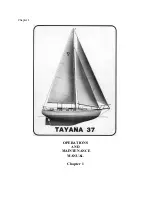
62
(a) Check fuel tank shut-off to be ON.
(b) Check fuel filter for sediment or water by opening drain plug on bottom. Replace plug.
(c) Follow routing of hoses from fuel filter to engine lift pump, inspecting hoses as you go. On the
engine pump, you will find a lever that allows you to manually operate the diaphragm inside,
against spring tension. It may be necessary to turn the engine over with the starter slightly to allow
the pump arm to relax against the camshaft. This allows more stroke with the manual lever you
are operating.
(d) Follow the fuel line from the pump to the engine fuel filter and locate the vent plug on top.
Loosen plug two or three turns.
(e) It is advisable to have some large rags on hand to catch oil that will be expelled from this point
in the course of bleeding.
(f) Begin operating the manual lever. This may take several minutes as the filters will need to fill
up (as well as the lines). Operate the manual lever until fuel flows freely from the filter plug with
no signs of air bubbles.
(g) Loosen the bleed screws on the injection pump.
(h) Operate pump again until fuel flows freely with no air bubbles.
(i) Re-tighten the vents beginning with the lowest point (the filter, the head locking screw, and the
governor vent screw). Wipe up any spills at this time.
(j) Slacken the union nut at the injection nozzles.
(k) Move throttle to full rpm and check to see if the “stop” control is in the RUN position.
(l) Crank engine with starter motor until fuel flows from each injector.
NOTE
: Do not run starter motor continuously. It normally takes 30 to 60 seconds of cranking to
completely bleed the injector lines. 20 seconds of cranking with about a two-minute rest between
periods will be easier on the starter, motor, and battery than steady cranking. Cranking the engine
for long periods may hydro-lock water into the engine cylinders.
(m) Re-tighten injector lines; wipe spills.
(n) Re-set throttle position and proceed with normal start-up.
(o) Allow sufficient running time to recharge battery.
HINT
: Very often Yanmar engines can be bled simply by loosening the bleed screw on top of the
engine oil filter and the bleed screw on top of the injection pump. Try it.
2. Drive Train
a.
Engine Alignment
The propeller shaft of the V-42 is 1-1/4 inch diameter stainless steel. The shaft is checked
for accuracy initially at the factory during installation and is carefully aligned to the engine
with the hull being properly supported and level. At this time, the shaft log and bearing is
bonded to the hull penetration. The coupling to the engine is checked again for alignment by
the commissioning team prior to delivery of the boat.
This alignment check should be made periodically, since the action of a rough sea could
possibly change the shape of a bolt enough to disturb engine alignment. If, after the first
rough water experience, the alignment has not changed, it is usually only necessary to make
the check once per season. This is extremely important.
Summary of Contents for VANCOUVER 42
Page 1: ...1 OPERATIONS AND MAINTENANCE MANUAL TAYANA VANCOUVER 42...
Page 2: ...2 Tayana V 42 Center Cockpit Sailplan...
Page 3: ...3 Tayana V 42 Aft Cockpit Interior Layout...
Page 12: ...12 Figure II 1 Fiberglass Layout Schedule...
Page 13: ...13 Figure II 2 V 42 Deck and Hull Joint...
Page 19: ......
Page 37: ...37 Figure IV 1 Fuel Supply Plumbing...
Page 38: ...38 Figure IV 2 Fluid Plumbing System...
Page 39: ...39 Figure IV 3 Center Cockpit Tankage Diagram...
Page 43: ...43 TABLE IV 1 Direct Current Energy Audit...
Page 48: ...48 Figure IV 6 Waste Water Plumbing System...
Page 51: ...51 Figure IV 8 Propane System...









































